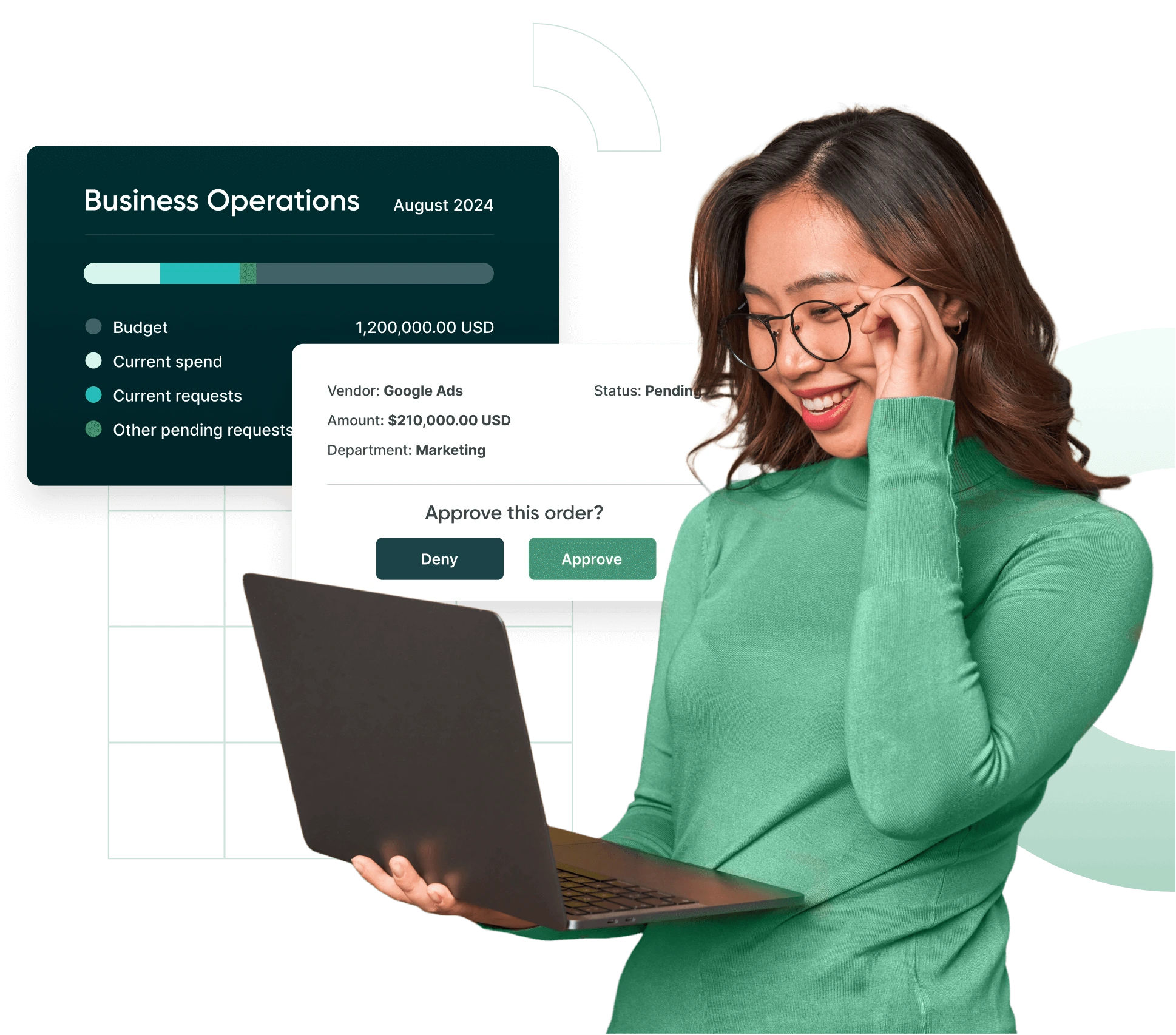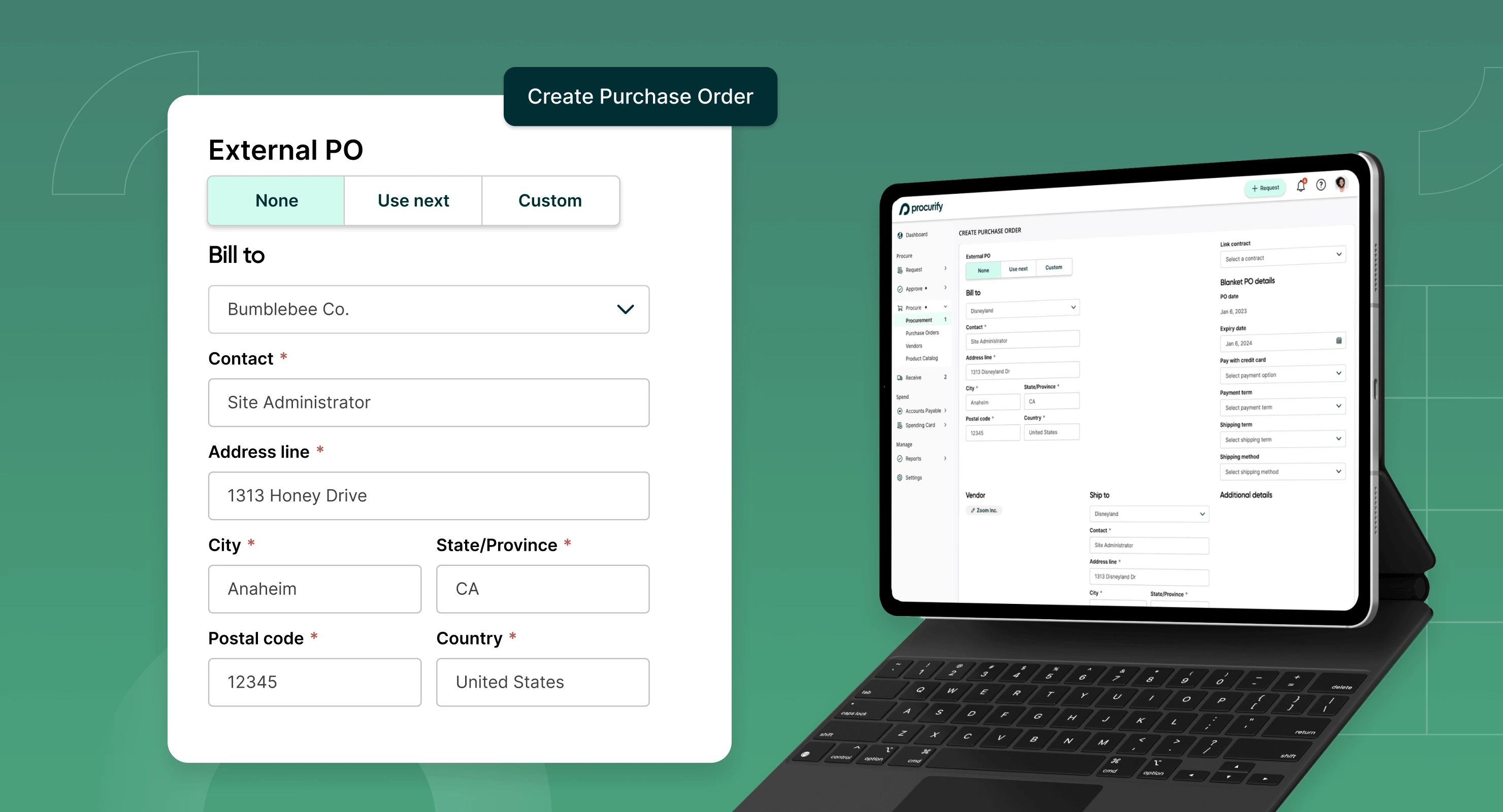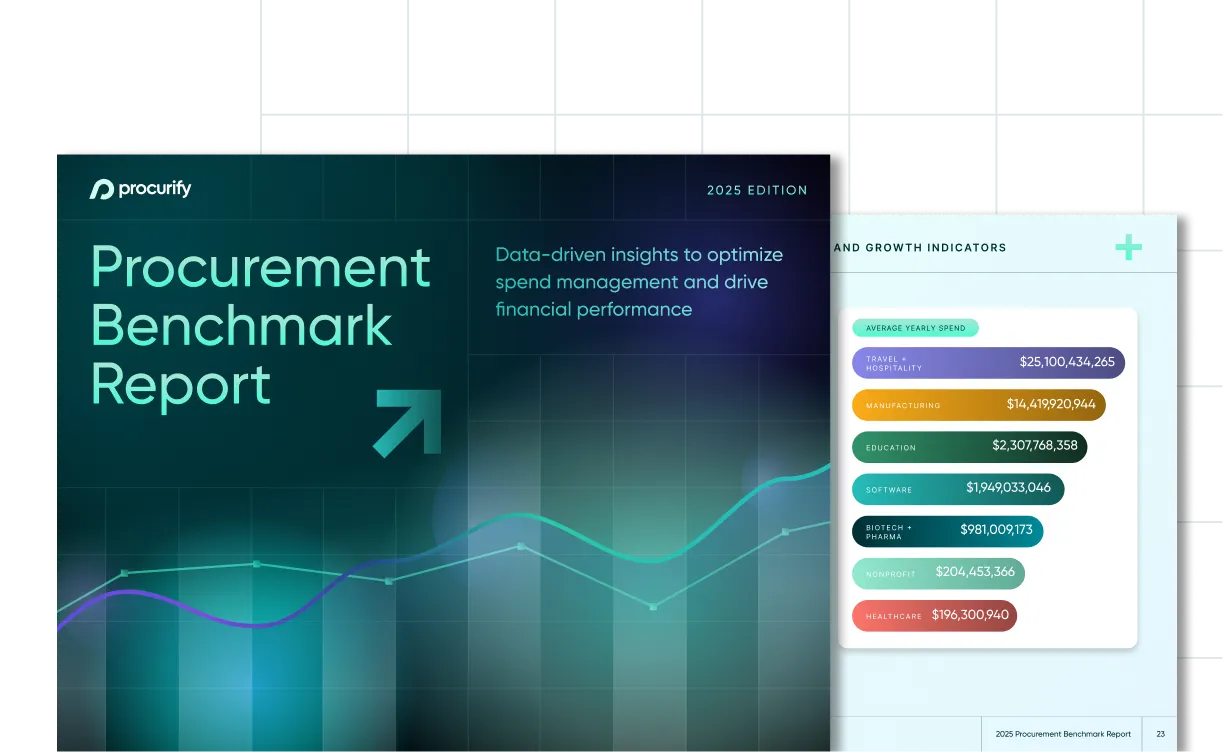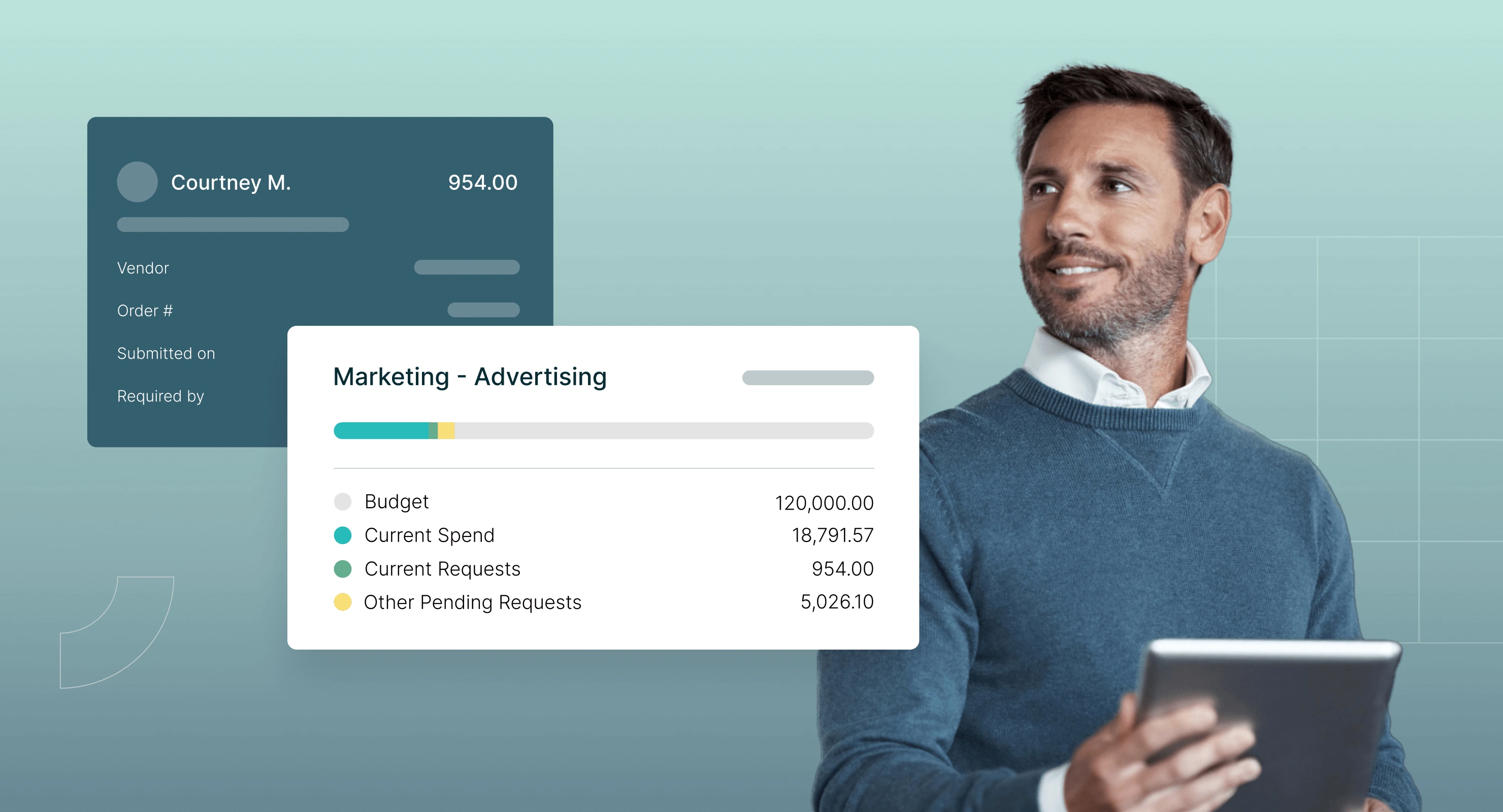
Procurement Management Software: A Comprehensive Guide for Procurement Officers
The ultimate goal for most businesses (other than to make profits of course) is to grow and scale.
As companies grow, their procurement processes become more complex. Managing multiple suppliers, contracts, and purchase orders can quickly become overwhelming without the right tools. This is where procurement management software comes in, helping to maintain operational efficiency and cost-effectiveness.
Procurement management software is designed to streamline and automate the entire procurement process, from requisition to payment, ensuring that businesses can operate smoothly and within budget. For procurement officers, finance leaders, and CFOs, understanding the value and capabilities of this software is essential in making informed decisions that create business sustainability as well as align with their company’s strategic goals.

Take control of spend with Procurify’s industry-leading procurement software
Book a personalized demo to see the Procurify’s advance procure-to-pay platform in action.
Core features of procurement management software
Procurement management software simplifies the procurement process by reducing manual tasks and enhancing decision-making. Here are some of the key features that make this software indispensable for modern businesses:
-
Automation and workflow management
Automation is at the heart of procurement management software. By automating routine tasks such as purchase order creation, approval workflows, and invoice processing, businesses can significantly reduce the time and effort required to manage procurement activities. Automation not only speeds up processes but also minimizes errors, ensuring that procurement operations run smoothly.
For example, a typical procurement process might involve multiple departments and several steps, each requiring approval. Procurement management software can streamline this by creating a predefined workflow that automatically routes documents for approval, notifies relevant stakeholders, and tracks the status of each task. This not only accelerates the process but also ensures compliance with company policies.
-
Vendor management
Effective vendor management is critical for maintaining strong supplier relationships and ensuring your company gets the best value for its purchases. Procurement management software offers comprehensive vendor management features, allowing businesses to track vendor performance, manage contracts, and maintain a centralized supplier information database.
These tools enable procurement teams to assess vendor performance based on criteria such as delivery times, quality of goods, and pricing. By analyzing this data, companies can make informed decisions about which suppliers to continue working with, which contracts to renegotiate, and where to seek new partnerships.
-
Budget tracking and control
Budget management is a top priority for any finance leader, and procurement management software provides powerful tools for tracking and controlling spend. With real-time visibility into budgets, companies can monitor expenses, forecast future spending, and ensure that procurement activities stay within budget.
The software often includes features such as customizable budget reports, alerts for budget overruns, and the ability to allocate budgets across departments or projects. This level of control helps prevent maverick spending and ensures that financial resources are used efficiently.
-
Reporting and analytics
Data-driven decision-making is essential in today’s business world, and procurement management software offers robust reporting and analytics tools. These tools allow procurement officers and finance leaders to generate detailed reports on spend analysis, supplier performance, compliance, and more.
By leveraging these insights, companies can identify trends, uncover inefficiencies, and make strategic adjustments to their procurement processes. Whether it’s tracking the performance of a particular supplier or analyzing the impact of a new procurement policy, these reports provide the data needed to make informed decisions.
Benefits of using procurement management software
Investing in procurement management software offers a range of benefits that can significantly improve a company’s operations, financial health, and overall efficiency. Here’s how this software can transform your procurement process:

-
Cost savings
One of the most compelling reasons to implement procurement management software is the potential for substantial cost savings. By automating procurement tasks, reducing manual errors, and optimizing purchasing decisions, businesses can lower their operational costs.
For instance, the software can help eliminate maverick spending—unapproved purchases that often result in higher costs. It can also streamline supplier negotiations by providing data-driven insights, leading to better pricing and contract terms.
-
Improved efficiency
Efficiency is at the core of procurement management software. By automating time-consuming tasks, the software frees up procurement officers and finance teams to focus on strategic activities rather than administrative duties.
For example, instead of manually processing purchase orders and tracking approvals, the software handles these tasks automatically, ensuring that everything is completed quickly and accurately. This not only speeds up the procurement process but also reduces the risk of errors that can lead to costly delays.
In industries where time is of the essence, such as healthcare or technology, this efficiency can be a game-changer, allowing companies to maintain smooth operations and meet their deadlines without unnecessary bottlenecks.
-
Compliance and risk management
Compliance with procurement policies and industry regulations is crucial for avoiding legal and financial risks. Procurement management software ensures that all procurement activities are carried out in accordance with company policies and regulatory requirements.
The software typically includes features such as automated audit trails, compliance checks, and contract management tools that help companies adhere to regulations and avoid penalties. By maintaining a clear record of all procurement activities, the software also facilitates easier audits and reduces the risk of non-compliance.
For finance leaders and CFOs, this level of compliance is invaluable, as it protects the company from potential fines, legal issues, and reputational damage.
-
Enhanced collaboration
Procurement management involves multiple stakeholders, from procurement officers and finance teams to suppliers and department heads. Effective collaboration among these stakeholders is essential for a smooth procurement process.
Procurement management software fosters collaboration by providing a centralized platform where all parties can access and share information in real-time. Features such as shared dashboards, mobile access, and instant notifications ensure that everyone stays informed and can make decisions quickly.
This level of collaboration is particularly beneficial for large organizations with complex procurement needs, as it ensures that all stakeholders are aligned and working towards the same goals.
How to choose the right procurement management software
Selecting the right procurement management software for your organization is a critical decision that can have a significant impact on your procurement efficiency and overall business performance. Here’s a step-by-step guide to help you make an informed choice:

2025 Procurement Benchmark Report
Powered by $20B+ in proprietary data you won’t find anywhere else.
-
Assessing your business needs
Before diving into the features and pricing of different software options, it’s essential to take a step back and assess your organization’s unique needs. Start by asking yourself the following questions:
- What are the key pain points in our current procurement process? Identify areas where inefficiencies, errors, or compliance issues are most prevalent.
- How complex is our procurement process? Consider the number of suppliers, purchase orders, and contracts you manage, as well as the frequency of procurement activities.
- What are our scalability requirements? Think about your company’s growth plans and whether the software can scale with your needs as you expand.
- Which departments and stakeholders will be using the software? Understanding who will interact with the system will help you choose a solution that is user-friendly for all involved.
By clearly defining your needs, you can narrow down the list of potential software options to those that align with your business objectives.
-
Key considerations when choosing software
Once you clearly understand your business needs, it’s time to evaluate the available software options. Here are some key considerations to keep in mind:
- Integration with existing systems: Ensure that the procurement software can seamlessly integrate with your existing systems, such as your ERP, accounting software, or CRM. This integration is crucial for maintaining data consistency and avoiding duplication of efforts.
- Scalability and flexibility: Look for software that can grow with your business. It should be flexible enough to adapt to changing procurement processes and accommodate additional users, suppliers, or locations.
- User-friendliness: The software should have an intuitive interface that is easy for all stakeholders to use. Complex software with a steep learning curve can lead to low adoption rates and inefficiencies.
- Customer support and training: Assess the level of customer support provided by the software vendor. Reliable support and comprehensive training resources are essential for a smooth implementation and ongoing use of the software.
- Security and compliance: Ensure that the software complies with industry standards and regulations, particularly if you operate in a highly regulated industry. Features like audit trails, secure data storage, and regular software updates are crucial for maintaining compliance.
-
ROI considerations
Investing in procurement management software is a significant decision, and understanding the potential return on investment (ROI) is key to making a sound choice. Here’s how to evaluate the ROI:
- Cost savings: Consider how much you’ll save by automating procurement processes, reducing manual errors, and improving supplier negotiations. Calculate potential savings in terms of reduced procurement costs, lower inventory levels, and fewer compliance issues.
- Efficiency gains: Estimate the time savings for your procurement team and other stakeholders. Faster procurement cycles and reduced administrative burdens can translate into significant productivity gains.
- Improved decision-making: With better data and analytics at your fingertips, you can make more informed purchasing decisions, leading to cost savings and better resource allocation.
- Long-term value: Consider the long-term benefits of implementing procurement software, such as improved supplier relationships, enhanced compliance, and the ability to scale your operations efficiently.
Future trends in procurement management
As technology continues to evolve, the landscape of procurement management is also undergoing significant changes. Forward-thinking organizations are already adopting emerging technologies and strategies to stay ahead of the curve. Here are some of the key trends that are expected to shape the future of procurement management:

-
Artificial intelligence (AI) and machine learning
AI and machine learning are transforming procurement management by automating complex decision-making processes, improving forecasting accuracy, and enhancing supplier selection. These technologies can analyze vast amounts of data to identify patterns, predict trends, and optimize procurement strategies.
- Predictive analytics: AI-powered predictive analytics can forecast future procurement needs based on historical data, helping organizations manage inventory levels more efficiently and avoid stockouts or overstock situations.
- Supplier risk management: Machine learning algorithms can assess and monitor supplier risks in real-time, flagging potential issues before they escalate into significant problems.
-
Blockchain technology
Blockchain technology is gaining traction in procurement management due to its ability to provide transparency, security, and traceability in supply chains. By creating a decentralized, immutable ledger of transactions, blockchain can ensure that all procurement activities are recorded accurately and securely.
- Transparency and trust: Blockchain allows all parties involved in a transaction to view the same data, reducing the risk of fraud and ensuring that all transactions are transparent and traceable.
- Smart contracts: Blockchain enables the use of smart contracts, which are self-executing contracts with the terms of the agreement directly written into code. These contracts automatically enforce compliance and payment conditions, reducing the need for intermediaries.
-
Sustainability and ethical sourcing
Sustainability and ethical sourcing are becoming increasingly important in procurement management. Consumers and stakeholders are demanding more transparency regarding the environmental and social impact of the products and services they purchase.
- Sustainable procurement practices: Companies are prioritizing suppliers who adhere to sustainable practices, such as reducing carbon footprints, minimizing waste, and using renewable resources.
- Ethical sourcing: Organizations are also focusing on ethical sourcing, ensuring that their suppliers uphold fair labor practices, respect human rights, and avoid exploitative practices.
-
Enhanced data analytics and reporting
As procurement becomes more data-driven, the ability to analyze and act on procurement data is becoming a critical differentiator. Advanced data analytics tools are enabling organizations to gain deeper insights into their procurement activities and make more informed decisions.
- Real-time reporting: Real-time reporting capabilities allow procurement teams to monitor spend, supplier performance, and compliance in real-time, enabling quicker responses to emerging issues.
- Advanced analytics tools: Tools that offer predictive and prescriptive analytics can help procurement leaders identify trends, optimize procurement strategies, and achieve better outcomes.
FAQs: Frequently asked questions
To help you make an informed decision about procurement management software, we’ve compiled answers to some of the most frequently asked questions.
Conclusion
In today’s fast-paced and ultra competitive business landscape, the name of the game is speed, accuracy, and efficiency. Advanced procurement management software achieves this and gives your company a competitive edge by leveraging emerging technology and creating a proactive spending strategy. This is how corporate growth is achieved in 2024.

2025 Procurement Benchmark Report
Powered by $20B+ in proprietary data you won’t find anywhere else.
